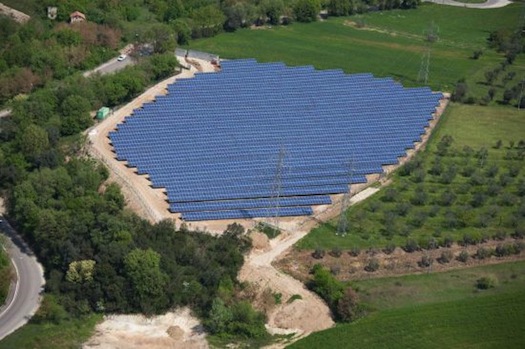
Solar farms in Italy. From Solar Thermal magazine.
Unsettling patches of metallic eczema have started appearing on former vineyards where I live in the south of France. They turn out to be solar farms, the first spores of a clean energy revolution that will soon cover the land. People tell me I should be pleased, but I feel foreboding.
The Energy Report, published today by the World Wildlife Fund, is not reassuring. It asserts that the world's energy needs could be met by wind, solar, geothermal, hydropower and sustainable forms of bio-energy — and by 2050. All we need is the guts to go for it.
Jim Leape, director general of WWF International, says the report is a "spur to global action." It aims to encourage governments, stymied in their search for an effective response to climate change and dwindling fossil fuel supplies, to "move boldly to bring the renewable energy economy into reality."
The Energy Report has been prepared by WWF together with renewable energy consultancy Ecofys, and AMO, the consulting arm of Rem Koolhaas's architecture firm OMA. It builds on two earlier large-scale projects: Zeekracht, the 2008 plan for a ring of offshore wind farms in the North Sea; and Roadmap 2050, launched last year, which advocates the decarbonization of European electrical power.
"A global energy supply based on renewables by 2050 is a universal issue which must be addressed at a global scale" says Reinier de Graaf, AMO's director. "It's so ambitious that it requires a new way of looking at the world in order to be understood." To help us perceive "a world without borders in which all continents have equal access to sustainable energy," AMO has created visualizations that bring the new realities of energy geopolitics into sharp focus.
The AMO image below makes the transfer of energy between South and North look especially clean and easy.
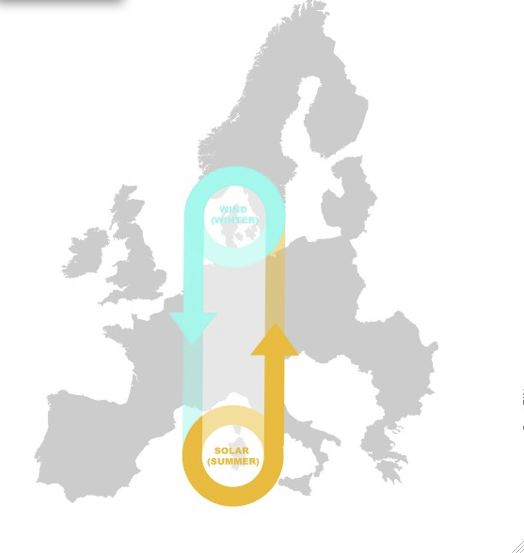
At first sight, the WWF report makes sense: There's a lot of wind in Northern Europe; there's a lot of sun in the South. Why not capture energy where it is not needed, in undeveloped countries, and transmit it to northern regions where people could use it, much as we do with oil and gas today?
At the heart of The Energy Report is the concept of a global scale "smart" electricity grid that would balance periods of low wind or sun in some areas by harvesting the wind or sun in others. This would reduce the need for back-up power systems and storage.
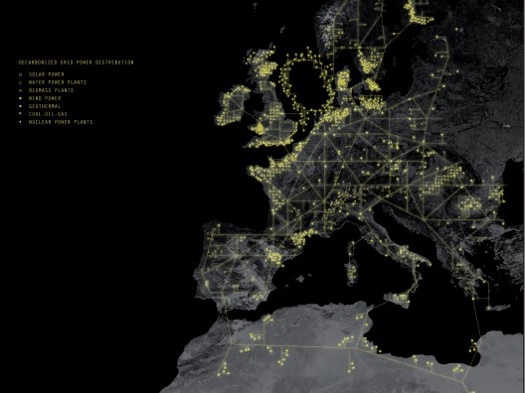
From AMO's Roadmap 2050.
In the benign vision outlined by the WWF efficient cables (HVDC) will run over very large distances — for example, between North Africa and Europe. These smarter grids, says WWF, can be consumer-friendly, save energy, reduce costs and increase reliability.
Behind the scenes, however, major energy players do not appear to regard locally produced power as an important part of the big picture. Energy “harvested” on a huge scale, in predominantly poor countries, is at the heart of their plans.
The World Bank, for example, is planning a grid to link the eastern Arab states with Egypt, Sudan and Ethiopia, the western outposts of the Arab world, and the Maghreb region of north Africa and the Western Sahara.
Another mega-plan, the European Union's Roadmap 2050, aims to create priority corridors in southwestern Europe "to make best use of Northern African renewable energy sources."
These supergrids look neat and hygienic on AMO's maps, but their implementation begs a host of questions. Among these is the process by which decisions are being made. The Energy Report states blandly that "the grid will allow power to be transferred from one part of the continent to another" — but allowed by whom, and in whose interests?
For ENTSO-E, the European Network of Transmission System Operators for Electricity, keen to ensure security of supply for 525 million energy-hungry Europeans, the biggest obstacle is "permitting procedures and authorization processes." It promises that its next ten-year plan, to be launched in 2012, will take "a more top-down approach."
The Energy Report also makes wind and sun energy sound clean and weightless when their impact on the real world is far less benign.
For one thing, renewables take up a lot of territory. Fossil fuels are concentrated, and buried underground. To achieve the same quantities of energy, renewables have to be spread over much wider areas: They need land for the equipment to capture the wind and the sun, land for power transmission infrastructure, land for access roads and buildings. It all adds up.
Bruce Pavlik, in a piece for the Los Angeles Times, warns that a rush to produce green energy could do irrevocable damage to fragile California ecosystems. Topsoil and plant life that have evolved over millenia are disrupted or destroyed by the placement of solar arrays, wind farms, power plants and transmission lines.
"We need to acknowledge the true costs of any energy development," warns Pavlik. "When a dam is built, a river is lost — but people who turn on their tap and draw that water rarely think about the river that was destroyed to produce it. If we place industrial technologies in what city people regard as wilderness, there will be less awareness of the damage, less incentive to conserve."
Despite such warnings, vast projects are in the pipeline. According to the LA Times, the total public land under consideration for alternative energy production exceeds 1.45 million acres in California alone.
In India, the negative impact of green energy is already starting to be felt. A wind farm project under way in Pune has destroyed protected forests and threatens farmland in the area. Bombay's High Court, responding to a public interest petition, ordered a halt on tree felling — but blasting and other destructive activities continue. At another wind power project, in Andhra Lake, 300,000 trees were felled by an Indo-German enterprise called Enercon to construct an access road along the hills; the consortium had permission to cut 26,000. Many rare plants and shrubs, found only in the western Ghats, have been destroyed because of dumping of rubble from blasted rocks.
Environmental activists allege the project was authorized on the basis of false promises that "there is no wildlife in the area."
In Ontario, Canada, crown land is being opened up to to renewable energy developers at low rates. These wild places may be rebranded as "wind parks" to divert opposition from community groups. As National Wind Watch reports, the majority of these renewable energy projects are controlled by multinationals, not by home-grown idealists, as some might imagine.
Renewables are also not as clean and light as they look in the photographs — only somewhat less dirty than the fossil fuels they are purported to replace. As equipment, wind farms use an awful lot of physical resources. The neat white compartments at the top of each tower each contain a generator, hub and gearbox that weigh upwards of 15,000 kilos (33,000 pounds). Other components of a utility-scale wind farm include underground power transmission systems in concrete culverts; high-tech control and maintenance facilities; and substations to connect farms with power grids. There's a lot of embodied energy in a single solar panel or wind turbine.
The Energy Report promises middle-class lifestyles for all, powered by renewable energy. For that to be achieved, vast numbers of these turbines would be needed. The journal Energy Policy estimates that four million 5 MW wind turbines would be required to supply 100 percent renewable energy by 2030 — not to mention 1.7 billion roof-mounted solar PV systems, 90,000 large solar power plants, plus a smattering of geothermal, wave and tidal power plants.
Four million turbines? We could probably add a zero, or two, to that number. In his book Sustainable Energy — Without the Hot Air, David MacKay, chief scientific advisor to the UK Department of Energy and Climate Change, reckons that the net energy contribution of one wind turbine is equal to the energy footprint of about 100 British people. According to MacKay's rough calculations, the maximum plausible production from on-shore windmills across the United Kingdom would (on average) be about one-fifth of all the "needs" we have today.
Chuck Burr, a southern Oregon farmer and writer, provides an additional reality check.. Cited by John Michael Greer, Burr uses hard numbers — a study of his own solar-powered home — to demonstrate that high-tech renewables cannot be a long-term solution. Burr is adamant: the photovoltaic system that powers his home will not generate enough electricity to maintain his modest lifestyle. If the energy used to manufacture transport and install the solar equipment is added in, the result is actually a net energy loss, he concludes.
"Every alternative energy solution is manufactured with fossil fuels. Think of the cables, the transformers, the pylons, the concrete they are mounted on. Renewable power is not renewable once these fossil fuel inputs are factored in," Burr says.
Whether the number of turbines required is in the millions, or tens or hundreds of millions, their manufacture will in any case be constrained by the availability of rare earth materials. One of these, neodymium, is not just used in the manufacture of the magnets used in wind turbines — it is also needed for electric cars. Pressure on supplies is already acute.
A report from Earth Policy is confident that any supply bottleneck could be overcome "if mining were increased by a factor of five" — but, like many of the promises in The Energy Report, there would be a hidden price to pay for that: A five-fold production increase in rare earth mining would have horrific consequences on the ground where it takes place.
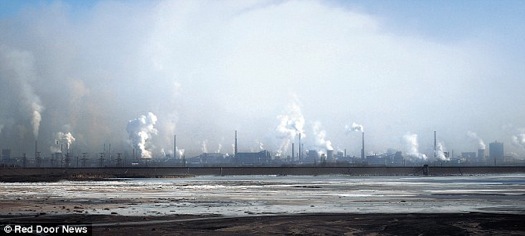
Tailing lake in Baotou, Mongolia, is a dumping ground for toxic byproducts of rare earth processing. Photo: Red Door News
Every step of the rare earth mining process is disastrous for the environment," states Jamie Choi, an expert on toxics for Greenpeace China. Ores are extracted by pumping acid into the ground; they are processed using more acid and chemicals; finally, they are dumped into tailing lakes that are often very poorly constructed and maintained. Throughout this process, large amounts of highly toxic acids, heavy metals and other chemicals are emitted into the air that people breathe, and which leak into surface and ground water that villagers rely on this for irrigation of their crops and for drinking water.
For their part, fishermen, too. are worried by offshore wind power. Wind turbines could one day straddle thousands of miles of rich fishing grounds in the waters south of Martha’s Vineyard and Nantucket, for example, if federal plans to accelerate growth in the offshore wind industry are realized. “Looking at the gridded map, it seems like they are going to take the whole Nantucket Lightship area away from us and about 80 percent of the Great South Channel area,” said Paul Wessecker, the owner of three local scallop vessels. “These are some of the most lucrative fishing grounds that we have.”
The optimistic projections of The Energy Report ignore another inconvenient reality: cost. Infrastructures on the scale it recommends would require massive inputs of investment in the form of fossil-fuel based energy, materials, knowledge, and labor. Even in a booming world economy, such resources would be hard to find; in the global crisis we are experiencing now, it is hard to see where even a fraction of the needed costs would be located.
At its heart, The Energy Report suffers from an existential flaw: It takes "global energy needs" as a given, adds up how much renewable energy would be required to meet them — and then ignores the true costs of deploying such an infrastructure. Apart from a vague commitment to "efficiency measures," the report fails totally to question the energy-intensive way of life that a spoiled 20 percent of us across the industrial world take for granted — from fresh strawberries at Christmas, to holidays in Mauritius.
The Energy Report does not lie outright. We could, theoretically, generate the vast quantities of renewables that it promises. But at what cost? David MacKay calculates that we could deploy renewables that would deliver nearly as much energy as we use today — but only "if we threw all economic, social, and environmental constraints to the wind."
That is what makes The Energy Report so dangerous. For the World Bank, construction and energy companies, and short-termist politicians, the report provides cover for profitable projects — and happy voters. Beguiled by the promise of “green jobs,” and the painless continuation of lifestyle-as-usual, many of us would be inclined to turn a blind eye to the environmental devastation, land-grabs, and undemocratic planning procedures that would follow.
For Rem Koolhaas and AMO, The Energy Report is a natural progression. Ecosystems and natural justice have never been a priority for the de facto house architect of globalizaton. As for Ecofys, the report's other partner, it's a technology company with no pretensions to be competent on social or environmental issues.
But The Energy Report is a tragedy for the WWF.
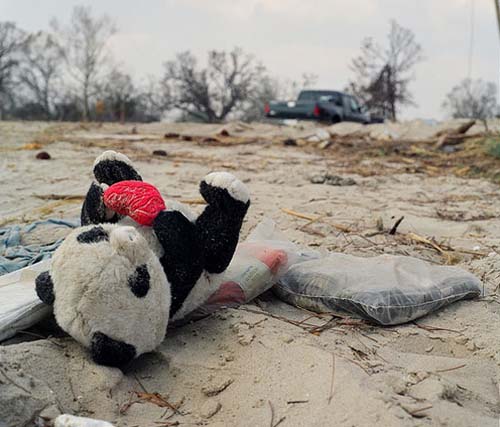
Its imprimatur provides cover for a Big Tech, growth-is-good, business-as-usual energy strategy that will not work. Worse, the WWF plan would divert resources from a more pressing priority: the creation of truly sustainable ways to organize daily life.
The biggest losers of all, if The Energy Report were to be implemented, would be people in so-called undeveloped societies, mainly in the south, who live without the vast energy throughputs we've become addicted to in the north. They should be our models, not our victims.
